Tales of Birdwatching in Door County
- Share
- Tweet
- Pin
- Share
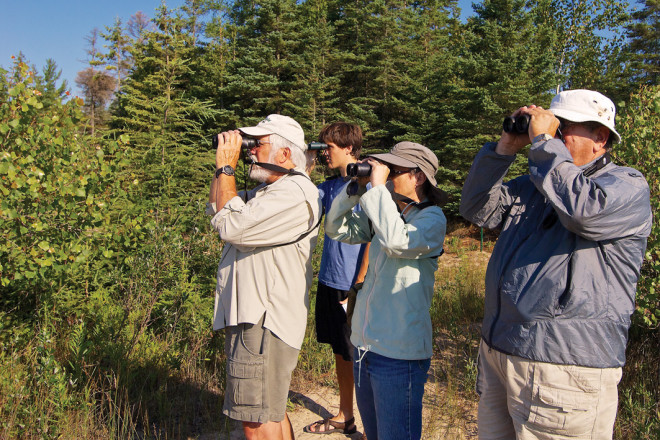
I imagine there are a lot of people as horrible at classifying the natural world as I am. I can’t tell a Lily of the Valley from a trillium or a muskie from a trout. And when it comes to birds, well, I know that most of them fly.
So as you can imagine, I felt a little overwhelmed when, on a morning in mid-July, I went out on my first birdwatching expedition. Thankfully, I was in good hands.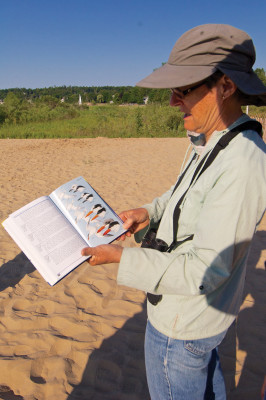
I’d recruited George Cobb, one of the leaders of the summer’s Saturday morning bird walks at The Ridges Sanctuary, to take me around to some of his favorite Baileys Harbor haunts and school me in the art of birding. And he’d brought along a few friends to make sure we had some extra pairs of watchful eyes and ears.
About a half hour in, we’d seen eight different types of birds, and George was standing and making a “pshhing” sound at a tree. He was trying to get a particularly shy Red-eyed Vireo to leave its hiding spot in the middle of a tree crag.
Jane Whitney, one of those extra pairs of eyes and ears, was looking for the bird, too, but she was also making fun of George.
“He knows you’re nothing special, George,” she said. “He isn’t coming out.”
It was then I realized, despite my lack of knowledge and experience, I was enjoying myself. I didn’t particularly know what to look for, but I was enjoying the thrill of the “hunt” and the camaraderie of the people that I was with.
Because of the variety of natural habitats on the peninsula, Door County is home to about a third of the 900 or so species of birds that reside in North America, and it also contains two of the 50 Bird Cities in the state of Wisconsin. What that means for birdwatchers, both amateur and expert, is there’s a lot to see out there and a lot to learn.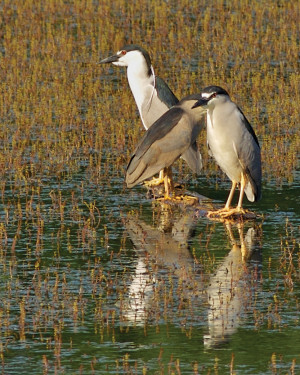
“It’s like a crossword puzzle,” says Bill Hartmann, an Ellison Bay birder who moderates the Door County Birding Yahoo! group. “You get various clues in sights and sounds, and you try to figure it out.”
Bill’s interest in birdwatching started with his wife, who took up the hobby 50 years ago and enticed Bill to take a naturalist trip to Costa Rica with her. He says that initially he didn’t understand his wife’s fascination with birdwatching, but it all clicked for him when he saw a familiar face in Costa Rica.
“It was a male Rose-breasted Grosbeak,” Bill says. “I’d seen that bird in Door County, and I said to myself, ‘Now how in the name of heaven did that bird get down here?’”
Now, Bill has a Birds of North America guidebook that’s filled with recorded dates and places of sightings, coordinated by color. He’s traveled the world and seen birds everywhere, including about 700 in North America alone. He was also part of a 2004 effort to publish a Door County guidebook of the various birds on the peninsula and the best time of year to spot them.
Bill says a quarter of the birds in Door County can be seen easily, if you’re willing to put in just a little bit of work. But there are some that are much rarer and only stop on the peninsula once in a great while.
 “Some of the most interesting and unusual birds have [been sighted] on Washington Island,” he says, scrolling through pictures on his iPad, showing me a Rufous Hummingbird, a Frigatebird, and a bird his group was unable to identify.
“Some of the most interesting and unusual birds have [been sighted] on Washington Island,” he says, scrolling through pictures on his iPad, showing me a Rufous Hummingbird, a Frigatebird, and a bird his group was unable to identify.
“Some are so similar that the only way to identify them is by their call,” says Bill. “In our records, we have this one listed as a Tropical/Couches Kingsbird.”
The Door County Birding Group started small 10 years ago, but has now grown to include over 65 members. Those members share their sightings via pictures and, often, email alerts, letting other birders know what is in their area.
But while a lot of birders seek out their quarries and build extensive lifelists of birds they’ve seen not only around their own state or country, but around the world, birding doesn’t have to be an adventure sport.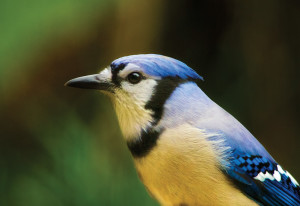
Bill says that some of the best birdwatching he’s done has happened at his kitchen window, and naturalist Paul Regnier says that he recently started keeping a “yard list” to tally just the birds he sees in his backyard.
“It can be whatever you want it to be,” says Paul, who teaches beginning birding classes at The Clearing. “It’s not like climbing a mountain, where you get to the top and you say, ‘Oh, I’m done.’ It’s something you can do all your life.”
All that you need to be a backyard birdwatcher is running water or a birdfeeder, but for those who want to step it up a notch, Regnier says there’s nothing better than finding a group to latch onto.
“You’ll learn twice as much in a tenth of the time,” he says. “You can’t learn by reading books. To really appreciate it you have to be out there doing it.”
As someone who talked to quite a few people for more than a few hours before actually doing any birdwatching of my own, I’d say there’s truth to Regnier’s words.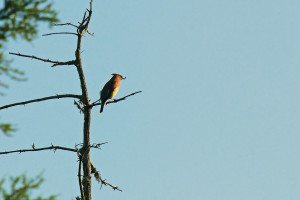
It’s one thing to talk about birds, to name-drop species and listen to counts and facts and figures. But to actually go birdwatching, to experience the sensation of really looking at and listening to nature, is something completely different.
According to George, my birdwatching group had a slow morning, seeing only about 18 different birds in the hour that we were out hiking. To me, almost all of those 18 birds were something new, if not a new sight, then at least I learned something new about them.
As I exited George’s car and prepared to start my workday, I made a mental note just in case I began to take up birding as a hobby myself. “Matt Ledger’s Lifelist: 18.”
Photography by Len Villano.
